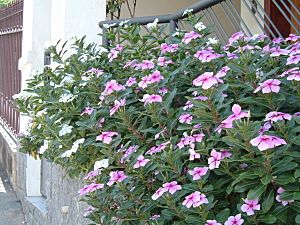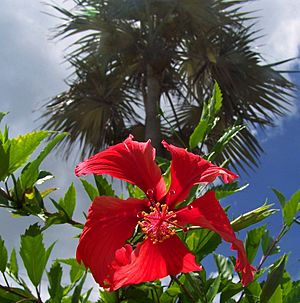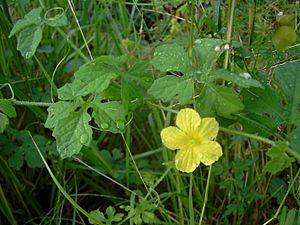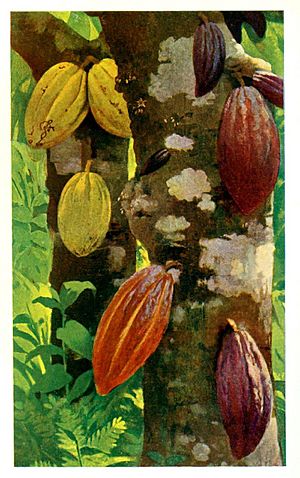Dominican tea culture facts for kids

Dominican tea culture is a mix of traditions from different groups of people who came to Dominica. "Bush teas" are a big part of Dominica's culture. These teas are made from local plants and are often used for health reasons.
Contents
What "Tea" Means in Dominica
Dominica has a tropical rainforest climate. This means many plants can grow there that are perfect for making teas.
The word "tea" in Dominica means more than just the regular tea you might know. In most English-speaking places, "tea" means a drink from the Camellia sinensis plant. This plant is usually imported from Asia. In Dominica, they call that kind of tea "green tea."
Dominicans also drink "Cocoa Tea." This is made from cocoa beans. They also have many kinds of "bush tea." Bush teas are made from herbs. Sometimes they use plant roots, bark, or flowers. People traditionally believe these plants have special healing powers. Dominicans also talk about "hot teas" and "cooling teas."
Sometimes, people in Dominica use the word "tea" to mean "breakfast." This started a long time ago when plantation workers would have "tea" (a small meal) at sunrise before going to work. They would have a second "tea" in the middle of the morning. This is different from how people in Britain use "tea," which often means a light meal with a cup of tea in the late afternoon.
Cocoa Tea: A Sweet Treat
Cocoa is a very important crop in Dominica. Many farmers traditionally grow it. You can find cocoa everywhere in Caribbean markets.
To make cocoa tea, you chop a cocoa stick or ball into small pieces. Or you can shred it with a grater. Then, you mix it with water, condensed milk, cinnamon, and leaves from a Christmas bush or bay leaves. You also add grated nutmeg and sugar. Cocoa tea is served hot. It often comes with a small snack, like banana fritters. Cocoa tea is a lot like hot chocolate.
Hibiscus Tea: A Colorful Drink

Hibiscus tea is very popular in Dominica. It's also popular in other Caribbean and Latin American countries. Hibiscus plants grow naturally in warm, tropical places. For a long time, people have believed that hibiscus has health benefits in traditional medicine. You can drink hibiscus tea hot or as an iced tea.
Some studies show that hibiscus tea might help lower blood pressure. This is for adults who have slightly high blood pressure.
Medicinal Teas: Nature's Helpers

People usually drink bush teas for health reasons. They might drink them to treat an illness or to stay healthy. Many common plants in Dominica are used to make these teas.
For example, tea made from Common Guava leaves is used for diarrhea. Tea from orange leaves is taken to stop throwing up. The bark of the Caribbean Albizia tree (Albizia niopoides) can be made into a tea that helps with scorpion stings. Other bush teas are used to help with not getting enough vitamins, tummy problems, or infections caused by tiny bugs.
Some plants believed to have healing powers are found at the Dominica Botanic Gardens. These include plants used in traditional teas in Dominica. There are also plants used in traditional medicine in other Caribbean islands and around the world.
The use of medicinal teas in Dominica goes back a long time. It started with the native Carib people. It also came from the knowledge of people brought to the islands from Africa. The Caribs traditionally made a tea from the leaves of the periwinkle plant (Catharanthus roseus). They used it to help treat diabetes.
Today, medicine companies take special chemicals called alkaloids from periwinkle sap. These chemicals include powerful anti-cancer medicines like vinblastine and vincristine. Other parts of periwinkle help lower blood sugar for people with diabetes. They are also used to make strong calming medicines. People in other cultures also knew how powerful this plant was. In France, it is known as Violette de Sorcier, which means "Sorcerer's Violet."
Scientists are still learning about the active ingredients in many of these plants. It's important to know that if these teas are used in the wrong amounts, they can be harmful or even deadly. Around the world, researchers are studying traditional plant medicines. They want to find out what active ingredients are in them. They also want to learn about how these plants were traditionally prepared. This research might help create new modern medicines.


